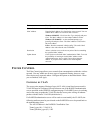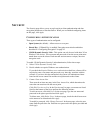40
• Fragment Length (256-2346) —The Fragment Length can be set between 256 and
2,346. If the packet size is smaller than the preset fragment size, the packet will not
be segmented.
Fragmentation of the PDUs (Package Data Unit) can increase the reliability of
transmissions because it increases the probability of a successful transmission due
to smaller frame size. If there is significant interference present, or collisions due
to high network utilization, try setting the fragment size to send smaller fragments.
This will speed up the retransmission of smaller frames. However, it is more
efficient to set the fragment size larger if very little or no interference is present
because it requires overhead to send multiple frames. (Default: 2346)
• RTS Threshold (0-2347)—Set the RTS (Request to Send) frame length. You may
configure the access point to initiate an RTS frame sequence always, never, or only
on frames longer than a specified length. If the packet size is smaller than the preset
RTS threshold size, the RTS/CTS mechanism will not be enabled.
The access point sends RTS frames to a particular receiving station to negotiate
the sending of a data frame. After receiving an RTS frame, the station sends a CTS
(Clear to Send) frame to acknowledge the right of the sending station to send data
frames. The access points contending for the medium may not be aware of each
other. The RTS/CTS mechanism can solve this hidden node problem.
(Default: 2346)
• Preamble Setting—IEEE 802.11 frames begin with an alternating pattern of 1s
and 0s called the preamble, which tells receiving stations that a frame is arriving.
This provides time for the receiving station to synchronize to the incoming data
stream. Enabling the Short preamble can boost your throughput; however, this can
cause interoperability issues. (Default: Long)
• Client Access Mode—802.11g radios can support both 802.11b and 802.11g
clients. This option determines which mode the radio will operate in and
consequently which clients will be able to connect to the radio interface. The
default is to provide information for both 802.11g and 802.11b clients. Higher
throughput can be achieved if the option for the 802.11g clients only is selected
(since the radio is not required to transmit at the lower 802.11b rates/method).
• Data Beacon Rate—Sets the interval at which a beacon will contain a delivery
traffic indicator message (DTIM). The Access Point sends a DTIM to signal clients
which are in sleep mode that a message is waiting to be delivered to them. The
range for this setting is 1-255 beacons. (Default: 2)


















